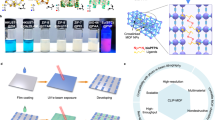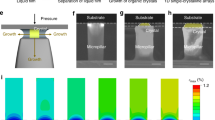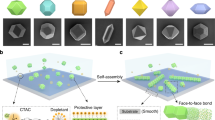Abstract
The fabrication of oriented, crystalline films of metal–organic frameworks (MOFs) is a critical step toward their application to advanced technologies such as optics, microelectronics, microfluidics and sensing. However, the direct synthesis of MOF films with controlled crystalline orientation remains a significant challenge. Here we report a one-step approach, carried out under mild conditions, that exploits heteroepitaxial growth for the rapid fabrication of oriented polycrystalline MOF films on the centimetre scale. Our methodology employs crystalline copper hydroxide as a substrate and yields MOF films with oriented pore channels on scales that primarily depend on the dimensions of the substrate. To demonstrate that an anisotropic crystalline morphology can translate to a functional property, we assembled a centimetre-scale MOF film in the presence of a dye and showed that the optical response could be switched ‘ON’ or ‘OFF’ by simply rotating the film.
This is a preview of subscription content, access via your institution
Access options
Subscribe to this journal
Receive 12 print issues and online access
$259.00 per year
only $21.58 per issue
Buy this article
- Purchase on Springer Link
- Instant access to full article PDF
Prices may be subject to local taxes which are calculated during checkout




Similar content being viewed by others
References
Furukawa, H., Cordova, K. E., O’Keeffe, M. & Yaghi, O. M. The chemistry and applications of metal-organic frameworks. Science 341, 1230444 (2013).
Kitagawa, S., Kitamura, R. & Noro, S. Functional porous coordination polymers. Angew. Chem. Int. Ed. 43, 2334–2375 (2004).
Jiang, H. C. et al. Pore surface engineering with controlled loading of functional groups via click chemistry in highly stable metal-organic frameworks. J. Am. Chem. Soc. 134, 14690–14693 (2012).
Deng, H. et al. Multiple functional groups of varying rations in metal-organic frameworks. Science 327, 846–850 (2010).
Eddaoudi, M. et al. Systematic design of pore size and functionality in isoreticular MOFs and their application in methane storage. Science 18, 469–472 (2002).
Yaghi, O. M. et al. Reticular synthesis and the design of new materials. Nature 423, 705–714 (2003).
Lee, L. Y. et al. Metal-organic framework materials as catalysts. Chem. Soc. Rev 38, 1450–1459 (2009).
Horcajada, P. et al. Metal-organic frameworks in biomedicine. Chem. Rev. 112, 1232–1268 (2012).
Kreno, L. E. et al. Metal-organic framework materials as chemical sensors. Chem. Rev. 112, 1105–1125 (2012).
Mondloch, J. E. et al. Destruction of chemical warfare agents using metal-organic frameworks. Nat. Mater. 14, 512–516 (2015).
Wang, C., Zhang, T. & Lin, W. Rational synthesis of noncentrosymmetric metal-organic frameworks for second-order nonlinear optics. Chem. Rev. 112, 1084–1104 (2012).
Cui, Y., Yue, Y., Qian, G. & Chen, B. Luminescent functional metal-organic frameworks. Chem. Rev. 112, 1126–1162 (2012).
Mahato, P. et al. Fast and long-range triplet exciton diffusion in metal–organic frameworks for photon upconversion at ultralow excitation power. Nat. Mater. 14, 924–930 (2015).
Li, J.-R., Sculley, J. & Zhou, H.-C. Metal-organic frameworks for separations. Chem. Rev. 112, 869–932 (2012).
Miyata, H. et al. Silica films with a single-crystalline mesoporous structure. Nat. Mater. 3, 651–656 (2004).
Zhang, H. et al. Aligned two- and three-dimensional structures by directional freezing of polymers and nanoparticles. Nat. Mater. 4, 787–793 (2005).
Allendorf, M. D., Schwartzberg, A., Stavila, V. & Talin, A. A. A roadmap to implementing metal–organic frameworks in electronic devices: challenges and critical directions. Chem. Eur. J. 17, 11372–11388 (2011).
Inagaki, S., Guan, S., Ohsuna, T. & Terasaki, O. An ordered mesoporous organosilica hybrid material with a crystal-like wall structure. Nature 416, 304–307 (2002).
Carretero-Genevrier, A. et al. Soft-chemistry-based routes to epitaxial α-quartz thin films with tunable textures. Science 340, 827–831 (2013).
Chen, Z. et al. DNA translocation through an array of kinked nanopores. Nat. Mater. 9, 667–675 (2010).
Richman, E. K., Brezasinski, T. & Tolbert, S. H. Vertically oriented hexagonal mesoporous films formed through nanometre-scale epitaxy. Nat. Mater. 7, 712–717 (2008).
Yamagiwa, H. et al. Detection of volatile organic compounds by weight-detectable sensors coated with metal-organic frameworks. Sci. Rep. 4, 6247 (2014).
Venkatesan, B. M. & Bashir, R. Nanopore sensors for nucleic acid analysis. Nat. Nanotech. 6, 615–624 (2011).
Phang, W. J. et al. Superprotonic conductivity of a Uio-66 framework functionalized with sulfonic acid groups by facile postsynthetic oxidation. Angew. Chem. Int. Ed. 54, 5142–5146 (2015).
Sun, L. et al. Electrically conductive porous metal-organic frameworks. Angew. Chem. Int. Ed. 55, 3566–3579 (2016).
Zacher, D., Shekhah, O., Wöll, C. & Fischer, R. A. Thin films of metal-organic frameworks. Chem. Soc. Rev 38, 1418–1429 (2009).
Falcaro, P. et al. MOF positioning technology and device fabrication. Chem. Soc. Rev. 43, 5513–5560 (2014).
Biemmi, E., Scherb, C. & Bein, T. Oriented growth of the metal organic framework Cu3(BTC)2(H2O)3 ⋅ xH2O tunable with functionalized self-assembled monolayers. J. Am. Chem. Soc. 129, 8054–8055 (2007).
Li, S. et al. Unconventional nucleation and oriented growth of ZIF-8 crystals on non-polar surface. Adv. Mater. 24, 5954–5958 (2012).
Arslan, H. K. et al. Intercalation in layered metal-organic frameworks: reversible inclusion of an extended π-system. J. Am. Chem. Soc. 133, 8158–8161 (2011).
Liu, J. et al. A novel series of isoreticular metal organic frameworks: realizing metastable structures by liquid phase epitaxy. Sci. Rep. 2, 921 (2012).
So, M. C. et al. Layer-by-layer fabrication of oriented porous thin films based on porphyrin-containing metal–organic frameworks. J. Am. Chem. Soc. 135, 15698–15701 (2013).
Makiura, R., Motoyama, S., Umemura, Y., Sakata, O. & Kitagawa, H. Surface nano-architecture of a metal–organic framework. Nat. Mater. 9, 565–571 (2010).
Zhuang, J. L., Terfort, A. & Wöll, C. Formation of oriented and patterned films of metal–organic frameworks by liquid phase epitaxy: a review. Coord. Chem. Rev. 307, 391–424 (2016).
Shekhah, O. et al. Controlling interpenetration in metal–organic frameworks by liquid-phase epitaxy. Nat. Mater. 8, 481–484 (2009).
Otsubo, K. et al. Step-by-step fabrication of a highly oriented crystalline three-dimensional pillared-layer-type metal–organic framework thin film confirmed by synchrotron x-ray diffraction. J. Am. Chem. Soc. 134, 9605–9608 (2012).
Liu, B. et al. Enantiopure metal-organic framework thin films: oriented SURMOF growth and enantioselective adsorption. Angew. Chem. Int. Ed. 51, 807–810 (2012).
Furukawa, S. et al. Heterogeneously hybridized porous coordination polymer crystals: fabrication of heterometallic core-shell single crystals with an in-plane rotational epitaxial relationship. Angew. Chem. Int. Ed. 48, 1766–1770 (2009).
Wannapaiboon, S., Tu, M. & Fischer, R. A. Liquid phase heteroepitaxial growth of moisture-tolerant MOF-5 isotype thin films and assessment of the sorption properties by quartz crystal microbalance. Adv. Funct. Mater. 24, 2696–2705 (2014).
Seo, S.-D. et al. Low-temperature synthesis of CuO-interlaced nanodiscs for lithium ion battery electrodes. Nanoscale Res. Lett. 6, 397 (2011).
Okada, K. et al. Copper conversion into Cu(OH)2 nanotubes for positioning Cu3(BTC)2 MOF crystals: controlling the growth on flat plates, 3D architectures, and as patterns. Adv. Funct. Mater. 24, 1969–1977 (2014).
Oswald, R. H., Reller, A., Schmalle, H. W. & Dubler, E. Structure of copper(II) hydroxide, Cu(OH)2 . Acta Cryst. C46, 2279–2284 (1990).
Chen, Y. & Washburn, J. Structural transition in large-lattice-mismatch heteroepitaxy. Phys. Rev. Lett. 77, 4046–4049 (1996).
Dix, J. A. & Verkman, A. S. Mapping of fluorescence anisotropy in living cells by ratio imaging. Application to cytoplasmic viscosity. Biophys. J. 57, 231–240 (1990).
Vrabioiu, A. M. & Mitchison, T. J. Structural insights into yeast septin organization from polarized fluorescence microscopy. Nature 443, 466–469 (2006).
Timr, S. et al. Nonlinear optical properties of fluorescent dyes allow for accurate determination of their molecular orientations in phospholipid membranes. J. Phys. Chem. B 119, 9706–9716 (2015).
Bloch, W. M., Champness, N. R. & Doonan, C. J. X-ray crystallography in open framework materials. Angew. Chem. Int. Ed. 54, 2–10 (2015).
Talin, A. A. et al. Tunable electrical conductivity in metal-organic framework thin-film devices. Science 343, 66–69 (2014).
Distefano, G. et al. Highly ordered alignment of a vinyl polymer by host–guest cross-polymerization. Nat. Chem. 5, 335–341 (2013).
Ikezoe, Y. et al. Autonomous motors of a metal-organic framework powered by reorganization of self-assembled peptides at interfaces. Nat. Mater. 11, 1081–1085 (2012).
Acknowledgements
This work was partly supported by a Grant-in-Aid for Scientific Research (B) (26288108), a Grant-in-Aid for Scientific Research on Innovative Area (26630322) from the Ministry of Education, Culture Sports, Science and Technology of Japan, and the Strategic Young Researcher Overseas Visits Program for Accelerating Brain Circulation from Japan Society of Promotion of Science. K.O. acknowledges JSPS Research Fellowship for Young Scientists. We acknowledge the use of facilities within the Monash Centre for Electron Microscopy. This research used equipment funded by the Australian Research Council grant LE110100223. P.F. acknowledges the Australian Research Council (DE120102451) and the ASTE JSPS schemes (Australia Japan Emerging Research Leaders Exchange and Invitation Fellowship programs). T.D.C. is acknowledged for helpful discussions. C.D. would like to acknowledge the JSPS for the visiting professorial fellowship. R. Makiura is acknowledged for helpful discussion and reference sample preparations.
Author information
Authors and Affiliations
Contributions
P.F. and M.T. conceived, designed and supervised the project with the help of A.H. and C.D.; K.O., T.H., K.I. and Y.T. performed the sample preparations, experiments and analysed the data; T.W., P.F. and M.T. performed TEM observations and analysed the results; A.W.T. performed the computational study of molecular simulations; P.F., K.O., C.D. and M.T. co-wrote the paper.
Corresponding authors
Ethics declarations
Competing interests
The authors declare no competing financial interests.
Supplementary information
Supplementary Information
Supplementary Information (PDF 3522 kb)
Supplementary Information
Supplementary movie 1 (MOV 26099 kb)
Supplementary Information
Supplementary movie 2 (MOV 8984 kb)
Supplementary Information
Supplementary movie 3 (MOV 9328 kb)
Rights and permissions
About this article
Cite this article
Falcaro, P., Okada, K., Hara, T. et al. Centimetre-scale micropore alignment in oriented polycrystalline metal–organic framework films via heteroepitaxial growth. Nature Mater 16, 342–348 (2017). https://doi.org/10.1038/nmat4815
Received:
Accepted:
Published:
Issue Date:
DOI: https://doi.org/10.1038/nmat4815
This article is cited by
-
Wearable respiratory sensors for health monitoring
NPG Asia Materials (2024)
-
Chemically routed interpore molecular diffusion in metal-organic framework thin films
Nature Communications (2023)
-
Site-specific anisotropic assembly of amorphous mesoporous subunits on crystalline metal–organic framework
Nature Communications (2023)
-
Natural oxidase-mimicking copper-organic frameworks for targeted identification of ascorbate in sensitive sweat sensing
Nature Communications (2023)
-
Low-dimensional assemblies of metal-organic framework particles and mutually coordinated anisotropy
Nature Communications (2022)



